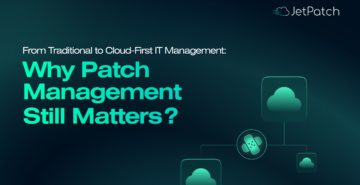Patch management is broadly recognized as essential for achieving security goals and preventing breach events. In fact, according to our primary research, 78% of organizations consider patch management to be important or critical to their business operations. However, many organizations still struggle with antiquated patch management processes that are reactive in nature, resulting in excessive IT administration efforts, cost overruns, and security failures. To enable efficient patch management, organizations should introduce continuous patch deployment processes that proactively prevent breach events while simultaneously reducing or eliminating burdens on IT support staff. Here are five key steps that must be implemented to achieve business-focused patch management.
1. Enable Holistic Visibility
It is impossible to secure what you do not know about. All supported systems and applications should be continuously monitored to identify their current patch levels and ensure they are the most recent versions. It is also important to monitor for the release of new patch distributions from software vendors so they can be rapidly deployed. Additional configuration and contextual information can be collected to help determine levels of risk posed by a particular device or user. This information may be attained from other management solutions, such as SIEM or systems management platforms.
2. Perform Intelligent Data Analysis
Once a rich set of information is collected, it should be evaluated by an intelligence technology (analytics, machine learning, etc.) to determine how patches should be deployed, such as by prioritizing the patch distributions based on the level of risk posed by the targeted vulnerability. Also, by establishing intelligence-based performance metrics, organizations can continuously monitor conditions across their IT environment to ensure SLA and regulatory compliance objectives are met.
3. Orchestrate End-to-End Patch Deployments
Actual deployment processes should be fully automated, including any pre- or post-deployment processes, such as dependency checks, communication with end-users, and clean process shutdowns and restarts. Complex deployment processes, including those requiring multiple restarts, should also be fully automated.
4. Support Flexible Scheduling
Organizations can avoid impacting user experiences by confining patch deployment to low-use times, such as on evenings or weekends. Urgent patch distributions may need to be imposed on users more rapidly, while low-risk patches may be deferred until the most convenient time. It is also advantageous when end users are able to provide some input into the patch distribution timing, particularly with low-priority patches.
5. Close the Loop on Patch Processes
After deployment processes are completed, a proactive patch management solution will review status logs and alerts to determine if any errors were detected during the installation. Also, tests should be performed on the target system or application to identify any bugs or compatibility issues with the patch. This “closes the loop” on patch deployments because the identification of patch deployment problems will likely initiate additional remediation steps, such as rolling back the patch.
Collectively, these key process and technology enhancements proactively ensure patch deployments complete successfully, preventing unnecessary breach events and workforce disruptions. In this way, patch management solutions serve the company rather than the other way around, driving improvements to security and overall business performance.



